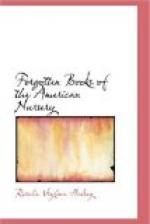It seems, however, to have been John Newbery’s publishing-house that made Mother Goose sponsor for the ditties in much the form in which we now have them. In Newbery’s collection of “Melodies” there were numerous footnotes burlesquing Dr. Johnson and his dictionary, together with jests upon the moralizing habit prevalent among authors. There is evidence that Goldsmith wrote many of these notes when doing hack-work for the famous publisher in St. Paul’s Churchyard. It is known, for instance, that in January, 1760, Goldsmith celebrated the production of his “Good Natur’d Man” by dining his friends at an inn. During the feast he sang his favorite song, said to be
“There was an old woman tos’t
up in a blanket,
Seventy times as high as the
moon.”
This was introduced quite irrelevantly in the preface to “Mother Goose’s Melodies,” but with the apology that it was a favorite with the editor. There is also the often quoted remark of Miss Hawkins as confirming Goldsmith’s editorship: “I little thought what I should have to boast, when Goldsmith taught me to play Jack and Jill, by two bits of paper on his fingers.” But neither of these statements seems to have more weight in solving the mystery of the editor’s name than the evidence of the whimsically satirical notes themselves. How like the author of the “Vicar of Wakefield” and the children’s “Fables in Verse” is this remark underneath:
“’There was an
old Woman who liv’d under a hill,
And if she’s not
gone, she lives there still.’
“This is a self
evident Proposition, which is the very essence of
Truth. She lived
under the hill, and if she’s not gone, she lives
there still. Nobody
will presume to contradict this. Croesa.”
And is not this also a good-natured imitation of that kind of seriously intended information which Mr. Edgeworth inserted some thirty years later in “Harry and Lucy:” “Dry, what is not wet”? Again this note is appended to
“See Saw Margery Daw
Jacky shall have a new master:”
“It is a mean and scandalous Practise in Authors to put Notes to Things that deserve no Notice.” Who except Goldsmith was capable of this vein of humor?
When Munroe and Francis in Boston undertook about eighteen hundred and twenty-four to republish these old-fashioned rhymes, in the practice of the current theory that everything must be simplified, they omitted all these notes and changed many of the “Melodies.” Sir Walter Scott’s “Donnel Dhu” was included, and the beautiful Shakespeare selections, “When Daffodils begin to ’pear,” “When the Bee sucks,” etc., were omitted. Doubtless the American editors thought that they had vastly improved upon the Newbery publication in every word changed and every line omitted. In reality, they deprived the nursery of much that might well have remained as it was, although certain expressions were very properly altered. In a negative manner they did one surprising and fortunate thing: in leaving out the amusing notes they did not attempt to replace them, and consequently the nursery had one book free from that advice and precept, which in other verse for children resulted in persistent nagging. The illustrations were entirely redrawn, and Abel Bowen and Nathaniel Dearborn were asked to do the engraving for this Americanized edition.




